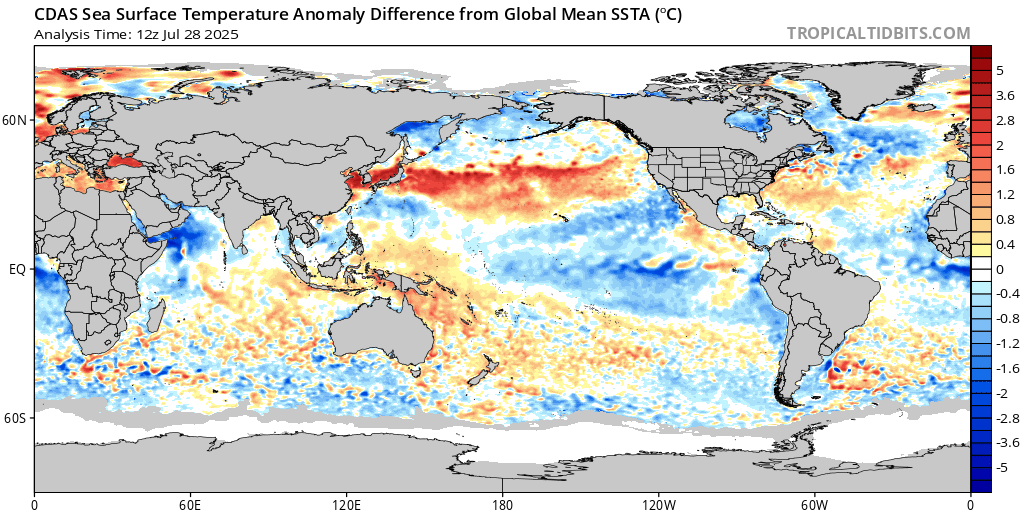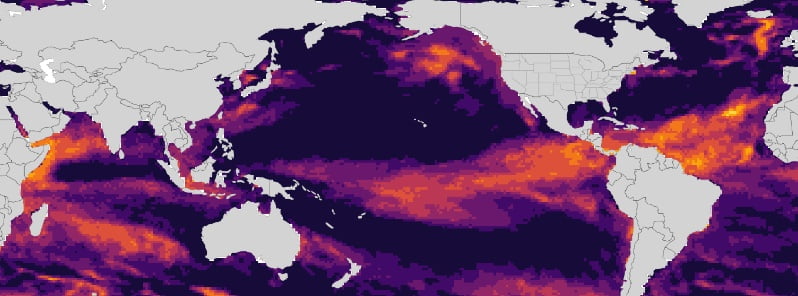|
|
Post by missouriboy on Jun 21, 2023 15:00:47 GMT
still very skeptical. correlation and causation? I agree. But geothermal inputs make somewhat more sense to me than CO2. And alternative hypotheses are useful. See new post under the active geology of the Earth as an input to climate.
Joe seems to think it is worth looking at.
I think I found Dr Viterito's email. Am going to contact him and invite him to visit our site.
|
|
|
|
Post by missouriboy on Jun 23, 2023 10:04:47 GMT
The Great Climate Shift of 2023-24 This has been touched on previously in the ENSO thread ... looking at NOAA's MODAS work that seem to show the positive shift to the N. Pacific Ocean in the late 1970s ... as discussed in the climate literature of that time ... The Great Climate Shift of 1976. Dr Dilley has charts in this video (where it is paused) that show the recent cooling trends in the N Pacific. MODAS seemingly shows the shift of warm water underway into the S. Pacific. Dr Dilley seems to believe that this will result in Northern Hemisphere cooling over the next couple of decades? He puts more emphasis on gravitational forces ... but I would note that these seem coincident with changes in solar cycle intensity. We (I) talk a lot about cycles. Legitimately, many of them are too far out to properly focus our attention. This one, however, is right on top of us. Within the next couple of years or so, we will see it verified or falsified. The wiggles will align, or not. The data say it has happened before. And, as others have noted ... when the AMO also goes negative ... weather in the northern hemisphere will document the changes.
|
|
|
|
Post by neilhamp on Jun 23, 2023 11:25:26 GMT
"And, as others have noted ... when the AMO also goes negative ... weather in the northern hemisphere will document the changes."
Can anybody explain why the AMO figures stopped being published in January 2023?
Thanks very much for your info Moboy
|
|
|
|
Post by missouriboy on Jun 23, 2023 12:14:03 GMT
"And, as others have noted ... when the AMO also goes negative ... weather in the northern hemisphere will document the changes." Can anybody explain why the AMO figures stopped being published in January 2023? Same message appears ...
The AMO is currently not updated due to the source dataset (Kaplan SST) not being updated. We have not decided what to do yet about this. We apologize for the inconvience.
|
|
|
|
Post by missouriboy on Jun 24, 2023 20:56:01 GMT
From Electroverse
the very cold waters off the western U.S. coast which, this spring, were among the coldest ever recorded. Northern San Diego’s Scripps Pier in La Jolla –for example– recorded a water temperature of just 52F in April, a reading just shy of the all-time coldest benchmark of 50F. Temperatures in San Diego itself have also been running below normal every month since November —
Find San Diego on this map. I remember Icefisher talking about the great cold water shift they saw in the early 1950s. That was a la nina.
 |
|
|
|
Post by nonentropic on Jun 25, 2023 9:26:59 GMT
|
|
|
|
Post by missouriboy on Jun 25, 2023 19:38:30 GMT
I plotted SOI, ENSO3.4, Sunpots and geomagneticAP for solar cycles 24 and 25. We already knew that ENSO 3.4 follows SOI (Chart top-left). Sunspots and Geomagnetic AP are generally but not always synchronous (Chart top right), and for now, SC25 sunspots and AP are higher than SC24. At certain points in the cycle, SOI seems more synchronous with Geomagnetic AP than with sunspots. Note the large El Nino of 2015 (Chart bottom left) and its positive relationship to AP (Chart Top right). AP is opposite (sign wise) SOI in first two solar sunspot pulses. Something changes. Now Sunspots and AP should start dropping into a lower state as its polar waves drop to the equator.
 |
|
|
|
Post by missouriboy on Jul 1, 2023 1:23:03 GMT
NOAA forecast indicates increase in global marine heatwaves through May 2024 watchers.news/2023/06/29/noaa-forecast-indicates-increase-in-global-marine-heatwaves-through-may-2024/
Marine heatwaves are periods of persistent anomalously warm ocean temperatures, which can have significant impacts on marine life as well as coastal communities and economies.
NOAA is about something new? No indication of how these heatwaves would differ from El Ninos. Are they preparing to declare victory even if no major El Nino develops?
 |
|
|
|
Post by nonentropic on Jul 1, 2023 5:21:25 GMT
|
|
|
|
Post by ratty on Jul 1, 2023 6:25:46 GMT
|
|
|
|
Post by nonentropic on Jul 1, 2023 8:19:24 GMT
So you proclaim reluctant compliance if I read that correctly.
|
|
|
|
Post by douglavers on Jul 1, 2023 12:17:21 GMT
You might note that the weather in Oz is a little strange at the moment.
Day before yesterday, the top temp in Alice Springs was 8 degC, about 11 degC below "normal".
It has also been raining enthusiastically across a large part of Northern Australia, in what is normally the dry season.
|
|
|
|
Post by missouriboy on Jul 1, 2023 13:44:17 GMT
SOI is doing very close to what it was doing at this point of SC24. For the next year it then declined across the face of SC24 into a brief Nina, increased at the second peak, and went bonkers on the backslope. All other things being equal, SOI will go back to negative reverse territory for about another year? Then, in SC24, came the big backslope kahuna (El Nino). I don't believe there is enough warm water left in the western warm pool to fund such an event. I could be wrong. But Doug is pointing to current events that might indicate cooler conditions in the western ocean and the atmosphere.
|
|
|
|
Post by ratty on Jul 2, 2023 0:58:02 GMT
So you proclaim reluctant compliance if I read that correctly. A Rumsfeld proclamation. |
|
|
|
Post by nonentropic on Jul 6, 2023 6:49:54 GMT
www.longpaddock.qld.gov.au/soi/I think its fair to say the SOI is disappointing to some folk but the reality is that the "super" in El Nino is gone. I would say solid neutral even.
|
|